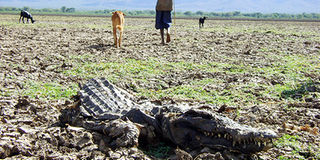Fighting climate change a marathon effort

A crocodile carcass lies on the dry bed of Lake Kamnarok in Kenya's Baringo North District. PHOTO | CORRESPONDENT | NATION MEDIA GROUP
What you need to know:
- Science says January and February 2017 were the warmest they have been three years in a row.
- Young people can contribute to Kenya’s handling of climate change to realise sustainable development and “leave nobody behind”.
Tackling climate change is a marathon team effort. When one of the runners gets cramp in the middle of the race, they receive help to relieve them of the discomfort and pain so they can continue running.
This analogy may be useful in examining the team players and the errant ones in the global climate change “marathon”.
The President of the United Nations General Assembly, Mr Peter Thomson, on March 23, hosted a high-level multi-stakeholder panel discussion on “Stocktaking on Climate — Paris Agreement Ratification, Science, Gaps and Opportunities”. It has been four months since the Paris Agreement of the United Nations Framework Convention on Climate Change (UNFCCC) became operational.
The joy and pain of this reality happening sooner than expected is getting all the rules of engagement in place to fully activate the blueprint of the Paris Agreement.
These rules will be further deliberated on in Bonn in May and November during the 46th and 47th inter-sessional meetings, respectively, of the Convention’s Subsidiary Bodies (SB46, SB47) with the intention of obtaining approval from the decision-making body, the Conference of the Parties, at their 23rd session (COP23).
SUSTAIN MOMENTUM
The start date for the Paris Agreement is 2020, when it replaces the Kyoto Protocol. Time is, therefore, of essence in having the rules ready, and getting consensus from 197 countries is no walk in the park. It may seem odd to be taking stock of this process four months before it comes into effect.
And yet the March 23 meeting provided an opportunity to sustain the momentum of the countries and their citizenry in speeding up their myriad climate actions and in the provision of financial support from 2017 to 2020.
At the same time, the meeting could be used to spur on the laggards, who it is known, have the financial, technological and human resource capacity to do more, but seem to be backtracking.
It may be of interest to be aware, and applaud Kenya, a member of the Climate Vulnerable Forum (CVF) comprising 48 countries from three continents, which face the greatest risk from climate change impacts and yet have committed to 100 per cent renewable energy.
And, it is not a contradiction that Kenya intends to utilise its coal and oil resources to facilitate its development. With an efficient energy mix of renewables, we can reduce our carbon footprint throughout the extraction, production, delivery and consumption supply chains.
GLOBAL TEMPERATURE
Science says January and February 2017 were the warmest they have been three years in a row. Climate change is about trends and global temperature is a key indicator of how warm the Earth is becoming. Essentially El Niño has made way for his sister La Niña.
Extreme weather events are increasing in frequency and intensity: 1) high precipitation - floods 2) low precipitation - drought and 3) sea-level rise.
These are leading to a growing number of natural disasters — weather, water-related, geological and biological — around the world. Kenya experiences extreme weather events that pose a threat to its people’s wellbeing and livelihoods and exacerbates conflicts.
Unfortunately, the more vulnerable countries lack the financial clout to alleviate the suffering of their citizenry, create and sustain climate resilience for their economies.
Young people, who are our treasure, can contribute to Kenya’s handling of climate change to realise sustainable development and “leave nobody behind”. Let us all do our part.
Ms Wandera is the secretary to the board and climate change focal point at the Sustainable Environmental Development Watch (Suswatch) Kenya. [email protected]




